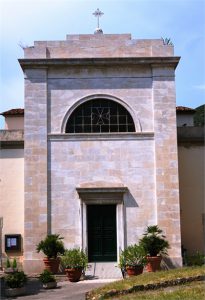 Titolare: Santi Ranieri e Luigi Gonzaga
Titolare: Santi Ranieri e Luigi Gonzaga
Unità Pastorale di San Giuliano Terme
Indirizzo della Parrocchia: Via XX Settembre, 2; 56017 San Giuliano Terme (PI)
PARROCO: GRZYWACZ Mons. TOMASZ
Abitazione del Parroco: Via Matteotti, 29 – Gello; 56017 San Giuliano Terme (PI)
Telefono del Parroco: +39.366.2447198 (WhatsApp)
E-mail del Parroco: padretomasz@gmail.com
SACERDOTE COLLABORATORE: DZRAMEDO Don GIUSEPPE
Abitazione del Sacerdote: Via Cellini, 3 – 56017 Orzignano; 56017 San Giuliano Terme (PI)
Telefono del Sacerdote: +39.3716134943 (WhatsApp)
E-mail del Sacerdote: jephlorenzo2@outlook.fr
| S. Messe a SS. Ranieri e Luigi Gonzaga in San Giuliano Terme | ||||||
| Lunedì | Martedì | Mercoledì | Giovedì | Venerdì | Sabato | Domenica |
| 17:00 | 10:00 |
Il granduca Francesco II di Lorena , nel 1740 autorizzò la costruzione di una nuova chiesa in Bagni di San Giuliano, su richiesta dell’Arcivescovo di Pisa Francesco dei Conti Guidi. La chiesa sostituì il piccolo oratorio di San Bartolomeo al Bagno posto nel centro del paese e venne dedicata ai Santi Ranieri e Luigi Gonzaga. Inaugurata nel 1748, assunse il ruolo di Parrocchia nel 1767 e venne affiliata all’ordine dei Cavalieri di santo Stefano, come ben evidenziano le molte croci dell’ordine stefaniano presenti all’interno e all’esterno.
L’interno della chiesa si presenta a croce latina, la navata è unica con due transetti in cui si trovano, a destra, l’altare dedicato alla Madonna delle Grazie, dove trova posto la tela di G.M.Franchi del 1751 e, a sinistra, quello dedicato a San Bartolomeo sormontato dalla tela di Ferretti del 1748 rappresentante il martirio del Santo, unico altare a mantenere intatta la struttura originaria. La tela posta nel presbiterio, sopra il coro, è opera settecentesca di Tommasi e rappresenta i due Santi Patroni. Le decorazioni presenti nei transetti, prebisterio e cupola sono del 1829 e attribuite a Giuseppe Bachini. L’altare attuale è in pietra di San Giuliano e risale al 1991.
********************
In 1740, upon the request of the Archbishop of Pisa Francesco dei Conti Guidi, Grand Duke Francis II of Lorraine authorised the construction of a new church in Bagni di San Giuliano. The church replaced the existing small oratory of San Bartolomeo al Bagno in the town’s centre and was dedicated to Saints Ranieri and Luigi Gonzaga. Inaugurated in 1748, it became a parish church in 1767 and was affiliated to the Order of the Knights of St. Stephen, as evidenced by the many crosses of the Order of St. Stephen inside and outside.
The interior of the church is shaped as the Latin cross. There is a single nave with two transepts in which we find, on the right, the altar dedicated to Our Lady of Grace, with a painting by G.M. Ranchi dated 1751 and, on the left, the altar dedicated to St Bartholomew surmounted by a painting by Ferretti dated 1748, depicting the martyrdom of the saint.
This is the only altar in the church which has kept the original structure. The painting in the presbytery, above the choir, is an 18th-century work by Tommasi and depicts the two patron saints. The decorations in the transepts, presbytery and dome date from 1829 and are attributed to Giuseppe Bachini. The current altar is
made of San Giuliano stone and dates from 1991
.
********************
Ciekawa książka: Ks. Wojciech Zyzak „Dorothy Day. Życie – Działalność – Duchowość”, Warszawa 2022.







